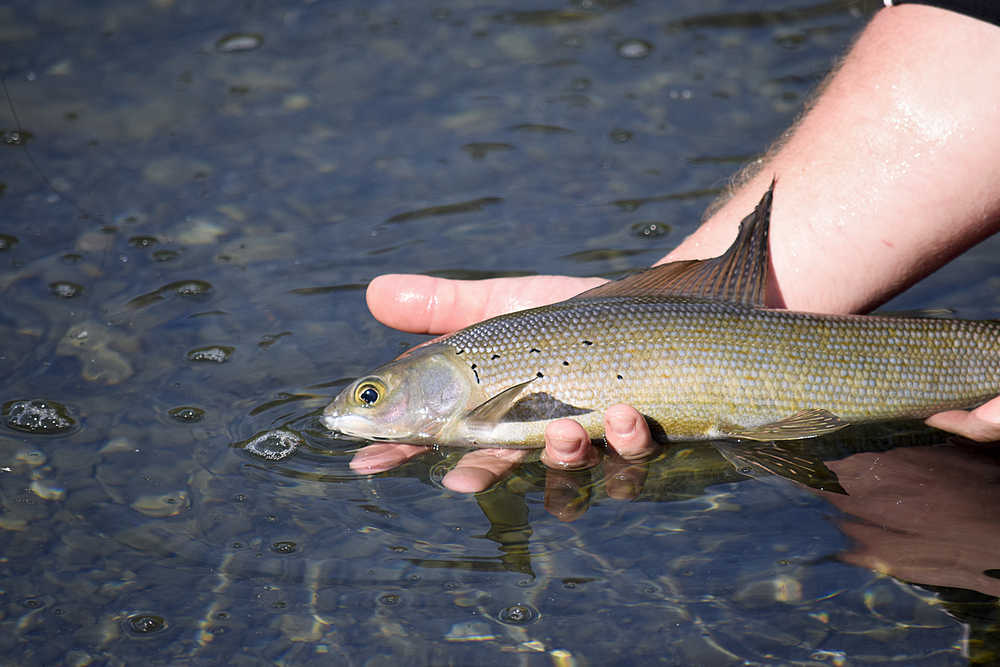Few things are as rewarding for a beginning fly fisherman than a forgiving fish that will bite at just about anything. For those willing to make the trek, grayling in the clear, cold lakes of the Kenai Mountains fit the bill nicely.
Whether on a fly rod or a spinning rod, anglers looking for a fish to learn on will find grayling willing and often eager to bite whatever is thrown their way.
“We’ve caught them on just about everything,” said Mark Conway with Alaska Fly Fishing Adventures. “We’ve even caught them on gum wrappers.”
On Crescent Lake in the Chugach National Forest, the grayling school in the early morning and late evening in water that’s clear enough to see every movement of a lure. It’s one of the three main road or trailhead accessible lakes where grayling can be found on the Kenai Peninsula and, like Bench Lake, is known for its population of larger grayling. Billy Coulliette, with Alaska Troutfitters, said a larger grayling on Crescent Lake could be 22 inches.
“Bench Lake is notorious for having some really large grayling up there,” he said. “Some of the biggest (on the Kenai Peninsula) are in there.”
The other easily accessible lake, Lower Fuller Lake, has smaller grayling that average about 8 inches long.
“A big one up there would be getting up to about 12 inches or so,” Coulliette said.
For a fly rod, Coulliette suggested a 3-5 weight, with an emphasis on the lighter weight on a calm day.
“On a three, you can land those big grayling,” he said. “It makes the fight really fun.”
A good leader would be the standard nine-foot tapered leader down to about 4-6 pounds, he said.
For a spinning rod, Coulliette suggested an ultra light setup with a 2- to 4-pound test line.
Coulliette and Conway said they like to take newer clients grayling fishing — though it is a popular type of fishing that brings a lot of repeat customers of all abilities.
“They’re great for beginners that are just learning to fly fish because they’re not too picky,” Coulliette said. “Sometimes the big ones will get a little selective on you, but not that often. If they’re feeding and it’s floating on the water, they’ll bite just about anything.”
Conway said the grayling were also more forgiving of a mis-cast than other species, like rainbow trout, would be.
“When they’re hungry, they’re not persnickety at all,” Conway said. “I bring new fly fishermen up there and they’re just delighted to catch something while they’re learning to cast.”
Grayling tend to school and cruise along in the lakes, so when they stop for food, an angler who is catching will catch plenty.
“They just stay in one area and they slowly move along the shoreline,” Conway said. “Anywhere a creek comes out into the lake you’re going to find the grayling there. They just graze and the schools are huge, we’re talking hundreds of fish in July.”
For budding fly fishermen, Conway said he likes to introduce them to fishing with dry flies on grayling.
For dry flies, Conway suggests the Parachute Adams size 14 or 16.
“It’s not real tiny, but it’s small,” he said. “Use a lot of the same dry flies you would use on trout. Parachute Adams always works.”
He also suggested the Royal Wulff in a 14 or 16 size.
“They’ll hit dry flies when it’s cloudless and not windy. They’ll just gobble up dry flies,” he said.
On a nymph fly, Conway suggested a bead-head, gold-ribbed with a pheasant tail in a small size 16 or 18.
“All of these mountain lakes have these small snails and freshwater shrimp called scuds,” he said. “If you were going to kill (a grayling) and eat it, you’d see the stomach is full of scuds and snails. For a wet fly — the scud — the bead head, gold rib pheasant tail is a good one and then in addition to that, I would go with some kind of small Woolly Bugger with a bead head in olive green or light brown or black.”
While there are other places in Alaska with larger or more populations of grayling, Conway said the Kenai Peninsula is unique in that there are places that are easily accessible by road.
“I have clients that have come up from the Lower 48 and from different countries and the grayling is on their bucket list,” he said. “Good grayling fishing is not really found anywhere else. Montana has some grayling and Colorado, but those are smaller — they don’t really have trophy grayling.”
Both Conway and Coulliette suggested that anglers who fish on spinning rods remove the treble hooks.
“They’ll suck the whole spinner down and then they get the treble hook in their tongue and once they do that, they’ll bleed to death,” Conway said. “That’s a killer.”
Reach Mark Conway at 907-362-1341 or at www.alaskaflyfishingadventures.net, or Billy Coulliette at 907-595-1212 or www.aktroutfitters.com.
Reach Rashah McChesney at rashah.mcchesney@peninsulaclarion.com or follow her on Twitter @litmuslens

